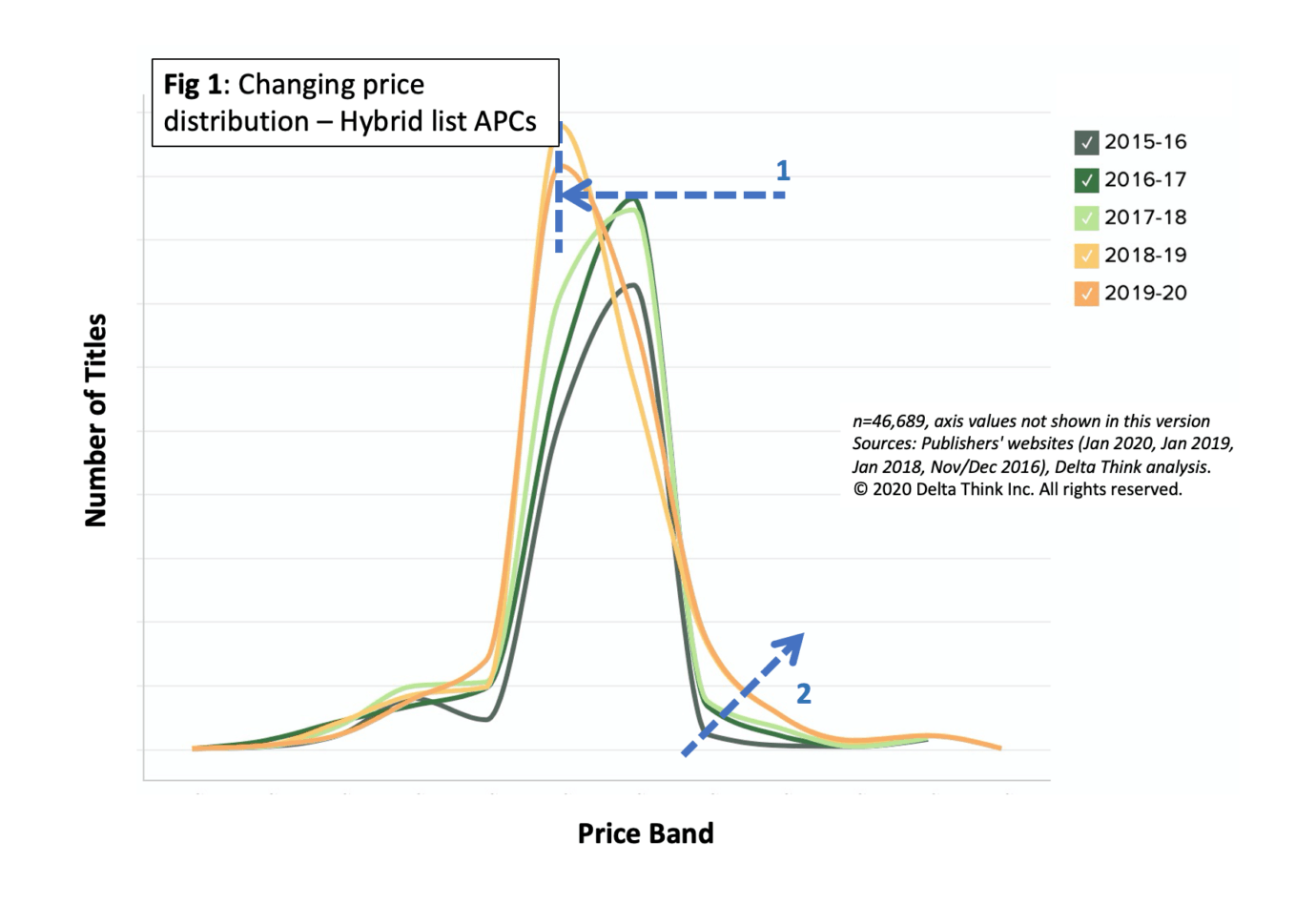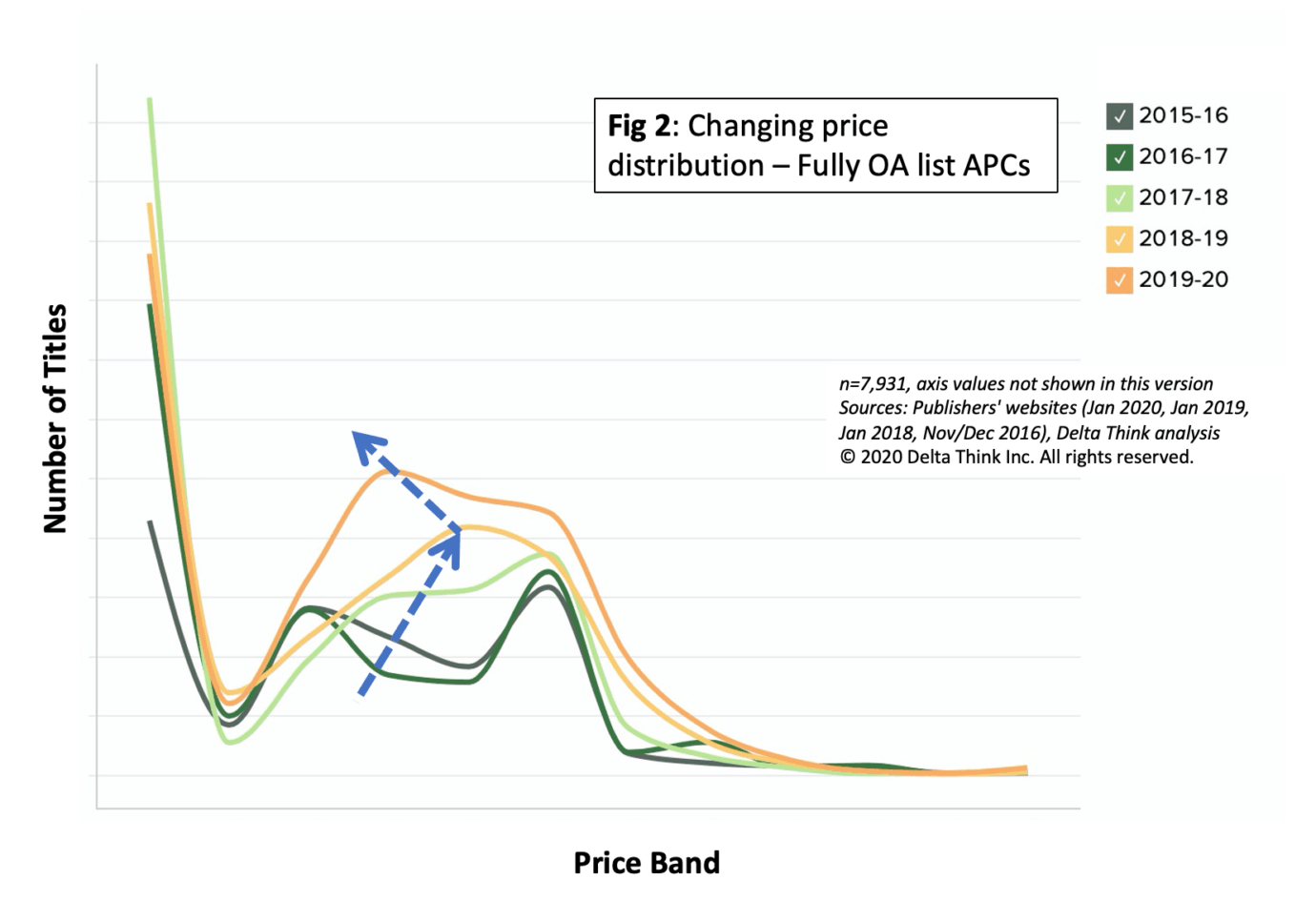Each year we survey the list Article Processing Charges (APCs) of a sample of major and significant publishers. Covering over 16,000 titles, this represents one of the most comprehensive reviews of open access pricing.
Headline Changes
To compare like for like, we analyze non-discounted, CC BY charges. Overall, list prices are increasing slowly:
- Maximum APCs for hybrid journals have risen noticeably, from $5,200 two years ago, to $5,650 last year, to $5,900 this year.
- The highest prices for fully OA journals have risen from $5,200 to $5,435.
- Fully OA journal APCs are less expensive than hybrid, averaging around 53% of hybrid average APCs. This difference has not changed significantly over the last few years.
- Average hybrid APCs continue to increase steadily, at very low single-digit percentages. Increases are accelerating slightly – from around 1% per year two years ago, to around 2% this year.
- This is contrasted with fully OA average price increases of 4% over the last year.
Shifts Within Portfolios
As is always the case, market-wide headlines mask nuances per publisher. Most – but not all – of the larger organizations have increased both fully OA and hybrid average APCs.
However, the most important nuance lies in the spread of prices within a given publisher’s portfolio. For example, if the bulk of a publisher’s journals lie towards the lower end of its pricing, with just a few journals priced much higher, the average (mean) price will be higher than most people actually pay.
The following figures show how this plays out in the market across our sample of publishers. The figures are histograms, showing how many titles sit in various price bands over the four successive years of data that we have. For illustrative purposes, we have outlined the trends. The “more orange” the lines, the more recent the prices. As usual, subscribers to Delta Think’s Open Access Data and Analytics Tool can see full details of axes.
For hybrid journals – as shown in Figure 1 below – the overall spread of prices has remained relatively constant over time. But, the most popular price band has shifted towards the lower end of the market to a steady state over the last couple of years (1). This means the average author is likely to pay a lower price compared with a few years ago. However, there is also a small but increasing likelihood authors attracted to the mid to higher range journals will pay increasing prices (2). Notice how the righthand side of the yellow curve becomes more shallow, suggesting an increase in popularity of mid to high range pricing.

The fully OA landscape is more complicated, as shown in Figure 2. The extreme left shows journals without APCs ($0). Their number appears to have fallen over the last couple of years. Moving to the right, a few years ago (green lines), there was a double-hump in the curve, suggesting two popular price bands. Over the last couple of years, the bands have merged into what amounts to a broad range of prices, with averages getting cheaper over time.

Conclusion
With almost 55,000 APC data points in our database, we are able to identify emerging trends in pricing. Hybrid prices appear to be holding steady, although – as we predicted this time last year – we see higher charges at the higher end of the market. Meanwhile, the lowest fully OA APCs are getting lower, and there seems to be a downwards move in prices of fully OA journals – a reversal of what we saw last year.
It appears that a two-tier market is emerging, with hybrid prices holding their own, and fully OA prices decreasing. We know from the detailed analysis we have previously run via our Data and Analytics Tool that authors are not particularly price sensitive when choosing journals. So, it’s likely that changes in pricing are more due to publishers’ proactive choices, than to market forces. Of course, this may change as the effects of Plan S and the possibility of a US executive order become apparent.

TOP HEADLINES
Testing a new approach to open access fees – March 3, 2020
“New OA payment models are needed make open access implementation practical, journal editor says…Dr. Steffen Huck, Professor of Economics at University College London and Co-Editor-in-Chief of Elsevier’s open access journal European Economic Review Plus (EER Plus), is looking at new options for OA by piloting the Editorial Processing Charge (EPC).”
Jisc, UK Institutions and Wiley Agree to Ground-Breaking Deal – March 2, 2020
“Jisc, the UK’s research and education not-for-profit that negotiates licences and digital content agreements on behalf of UK universities, and Wiley, a global leader in research and education, have struck a four year ‘read and publish’ agreement that offers researchers at UK universities the means to publish open access (OA) in all Wiley journals at no direct cost to them.”
SAGE launches portal to streamline open access publishing process – February 24, 2020
“SAGE Publishing announces the launch of a new portal that enables authors, consortia, libraries, and funders to manage the open access publishing workflow. Named the SAGE Open Access Portal, the platform currently supports SAGE Choice, the publisher’s hybrid Open Access (OA) publishing option, for 900+ journals. Later in 2020, it will be extended to support SAGE’s 180+ pure Gold OA journals.”
Project to explore OA agreements with publishers and library consortia in developing and transitioning economy countries – February 24, 2020
“Three learned society publishers — the European Respiratory Society, IWA Publishing, and The Company of Biologists – will work with EIFL (Electronic Information for Libraries) to explore whether and how OA agreements might be piloted to support a global transition to OA.”
Read-and-Publish Open Access deals are heightening global inequalities in access to publication – February 21, 2020
“Whilst these deals have streamlined open access provision in the Global North, Jefferson Pooley argues that they lock in and exacerbate existing inequalities in scholarly publishing, by establishing and entrenching a two-tier system of scholarly publishing based on access to funds needed to meet publishing charges.”
Open access journals get a boost from librarians – February 14, 2020
“Open access publishing—the move to break down paywalls and make scientific research free to read—is upending the funding model for journals, at the behest of regulators and some big research funders, while online tools and the illicit Russian pirate-site Sci-Hub are taking readers.”
New business models for the open research agenda – February 14, 2020
“The rise of preprints and the move towards universal open access are potential threats to traditional business models in scholarly publishing.”
New Measure Rates Quality of Research Journals’ Policies to Promote Transparency and Reproducibility – February 10, 2020
“Today, the Center for Open Science launches TOP Factor, an alternative to journal impact factor (JIF) to evaluate qualities of journals. TOP Factor assesses journal policies for the degree to which they promote core scholarly norms of transparency and reproducibility. TOP Factor provides a first step toward evaluating journals based on their quality of process and implementation of scholarly values.”
OA JOURNAL LAUNCHES
February 28, 2020 | “CABI has announced the launch of a journal to publish original research and data in all fields related to agriculture and the biosciences. CABI Agriculture and Bioscience, the official journal of CABI, will be managed by BMC, part of Springer Nature.” | |
February 27, 2020 | “APS is gearing up to launch a new member of the Physical Review family of journals. PRX Quantum will be a highly selective, open access journal focused on quantum information science and technology with an emphasis on research with lasting and profound impact. The new journal is expected to open for submissions in the coming months.” | |
February 26, 2020 | Introducing Materials for Quantum Technology – a new open access journal from IOP Publishing | “IOP Publishing has launched Materials for Quantum Technology, a new fully open access journal devoted to the development and application of materials science for all quantum-enabled technologies and devices.” |
February 25, 2020 | New ACM Journal Explores How Technology Is Transforming Government | “ACM, the Association for Computing Machinery, today announced the inaugural issue of Digital Government: Research and Practice (DGOV), a new interdisciplinary open access journal on the impact of technology on governance and public institutions.” |
February 21, 2020 | Official EASE journal European Science Editing goes diamond OA with ARPHA | “Starting from 2020, European Science Editing (ESE), the official journal of the European Association of Science Editors (EASE), has been relaunched as a fully Open Access journal with all content freely available and published as soon as accepted, on a new journal website hosted on the ARPHA platform.” |
February 18, 2020 | “A new open access journal from Cambridge University Press – QRB Discovery – will provide an outlet for exciting new discoveries in the burgeoning field of biophysics…The focus forQRB Discovery will be on biological phenomena that can be described and analysed from a molecular angle.” | |
February 18, 2020 | Announcing the launch of BIO Integration – a new fully open access journal | “The publications division of Compuscript Ltd announces the launch of its newest open access journal, BIO Integration (BIOI). The journal represents a bold new step toward open science for the global medical community. The fully open access journal will allow for the rapid dissemination of multidisciplinary views driving the progress of modern medicine.” |
February 4, 2020 | “Today the Royal Society of Chemistry announces the launch of Materials Advances, sister to Journal of Materials Chemistry A, B and C. The new journal will be free to read and free to publish in for two years.” |

